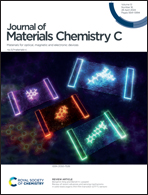Fast ultraviolet detection response achieved in high-quality Cs3Bi2Br9 single crystals grown by an improved anti-solvent method†
Abstract
Metal halide perovskites are extensively utilized in photoluminescence and photoelectric detection, owing to their modifiable band gap, elevated quantum yield, high absorption coefficient, superior charge transport properties, versatile chemical synthesis, and cost-effective manufacturing. Among the perovskite variants, bismuth–halide perovskites have emerged as a promising lead–halide alternative, garnering increasing interest for crafting non-toxic perovskites in optoelectronic applications. Nonetheless, the rapid and straightforward production of high-quality single crystals remains a challenge. This paper introduces an enhanced antisolvent crystallization method for fabricating high-quality Cs3Bi2Br9 single crystals measuring 3 × 3 mm. These crystals exhibit a remarkably low half-peak width of the X-ray diffraction swing curve at just 0.048°, maintaining stability without phase decomposition for 180 days at room temperature under air exposure. The photodetector constructed involves an aluminum electrode deposited onto the crystal surface. Utilizing 375 nm ultraviolet light as the excitation source, the device demonstrates a swift electrical response (sensitivity: 8.41 × 102), achieving the rise and decay times of the Cs3Bi2Br9 single crystal detector of 96 and 80 milliseconds, respectively. This research holds significant promise for advancing perovskite crystal preparation and photodetection techniques, particularly in the realm of bismuth-based perovskites.



 Please wait while we load your content...
Please wait while we load your content...